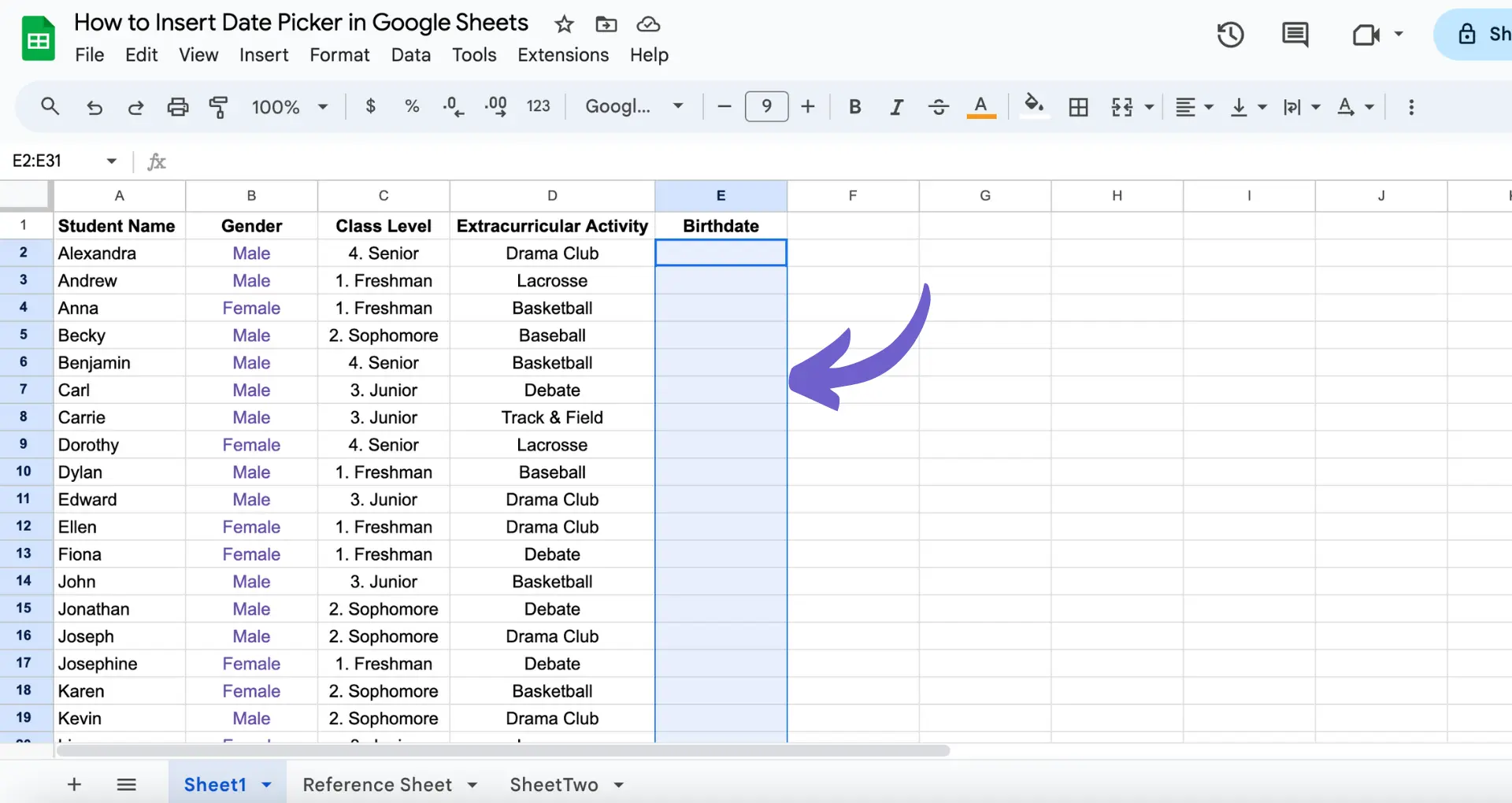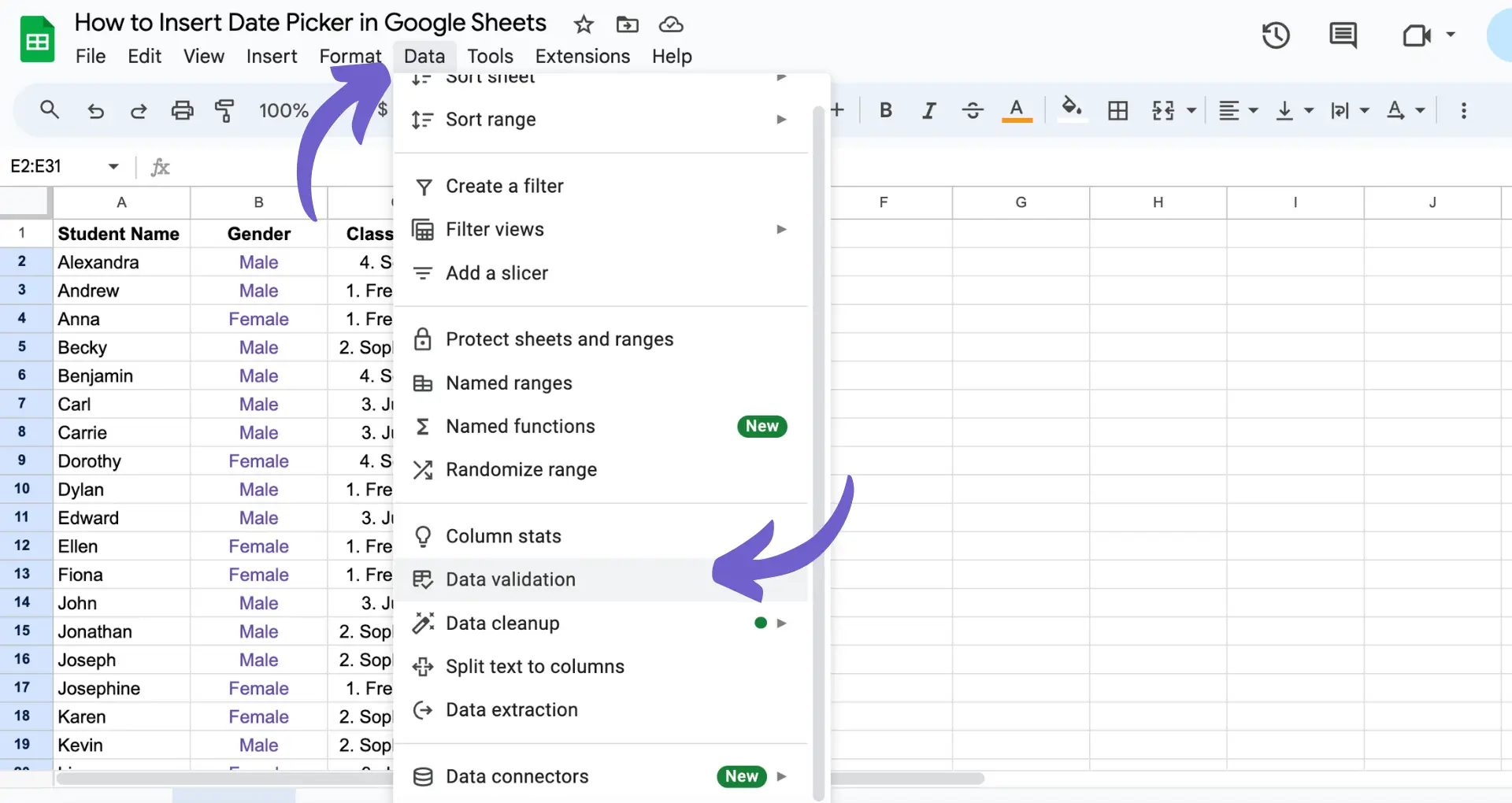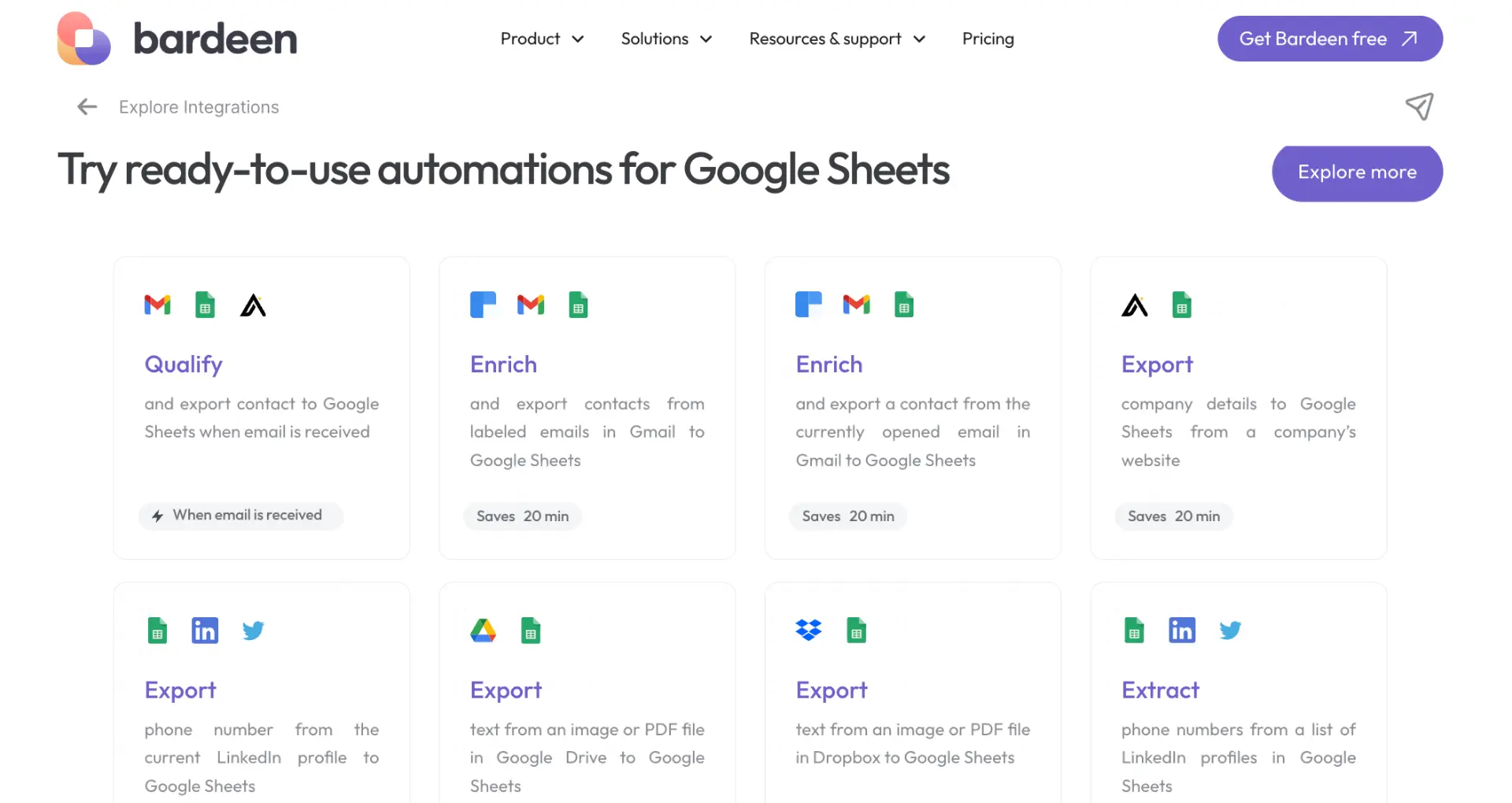Select cells, go to Data, then Data validation, and choose Date.
By the way, we're Bardeen, we build a free AI Agent for doing repetitive tasks.
If you work with dates in Google Sheets, you might love Bardeen's GPT in Spreadsheets. It automates date entry and more, saving you time and reducing errors.
Inserting a date picker in Google Sheets is a simple yet powerful way to streamline data entry and ensure consistency. In this step-by-step guide, we'll walk you through the process of setting up a date picker using the Data Validation feature, customizing date formats, and exploring practical uses for this handy tool. By the end of this article, you'll be able to easily incorporate date pickers into your Google Sheets workflow, saving time and reducing errors.
Understanding the Basics of Date Picker in Google Sheets
A date picker is a handy tool that simplifies the process of entering dates in Google Sheets. It appears as a small calendar icon next to the cell you're editing, allowing you to select a date without manually typing it in. This feature not only saves time but also ensures consistency and reduces the risk of input errors.
Using a date picker in Google Sheets offers several advantages:
- Streamlines data entry by eliminating the need to type dates manually
- Ensures date format consistency across your spreadsheet
- Reduces the likelihood of input errors, such as typos or incorrect date formats
- Provides a visual representation of dates, making it easier to select the desired date
- Allows for quick navigation between months and years
GPT in Spreadsheets can further enhance your productivity in Google Sheets.
Bardeen can help you automate tasks that involve adding or updating data in Google Sheets on a specific schedule, which is particularly useful when working with date-related data. Try these playbooks:
Date pickers are particularly useful when working with:
- Project timelines and deadlines
- Event planning and scheduling
- Data analysis involving date ranges
- Creating and managing calendars
- Tracking important milestones or anniversaries
By leveraging the date picker feature in Google Sheets, you can significantly enhance your productivity and streamline your workflow when dealing with date-related data.
Setting Up a Date Picker Using Data Validation
To set up a date picker in Google Sheets, you'll need to use the Data Validation feature. Here's a step-by-step guide:
- Select the cell or range of cells where you want the date picker to appear.
- Go to the "Data" menu and click on "Data validation."
- In the "Criteria" section, choose "Date" from the dropdown menu.
- Specify any additional restrictions, such as a date range, if desired.
- Click "Save" to apply the data validation settings.

Now, when you double-click on a cell within the specified range, a date picker will appear, allowing you to easily select a date.
It's crucial to select the correct data validation settings to ensure the date picker functions properly. Make sure to:

- Choose the appropriate cell range
- Select "Date" as the criteria
- Set any necessary date range restrictions
- Save the settings before exiting the data validation dialog
By following these steps and selecting the correct settings, you'll have a fully functional date picker in your Google Sheets, making date entry a breeze.
Bardeen can also help you save time by automating data collection and organization in Google Sheets. Try these playbooks to quickly populate your spreadsheets with data from various sources:
For more advanced setups, consider using Google Sheets integrations to connect your sheets with other tools.
Try Bardeen's Google Sheets integrations to save time and boost productivity by automating repetitive tasks.

Customizing Date Formats and Restrictions
Google Sheets offers flexibility in customizing date formats to suit your specific needs. To customize the date format:
- Highlight the cells containing the dates you want to format.
- Click on "Format" in the menu bar and select "Number" followed by "More formats" and "More date and time formats."
- In the "Custom date and time format" dialog box, you can either select a predefined format or create your own using the provided syntax.
- Use characters like "m" for month, "d" for day, and "y" for year to create your desired format (e.g., "mm/dd/yyyy" for a two-digit month, two-digit day, and four-digit year).
- Click "Apply" to implement the new date format.
Bardeen can automate the process of collecting and organizing data with dates from various sources into Google Sheets, ensuring consistent date formatting and saving time from manual data entry. Try these playbooks:
To set restrictions on date ranges:
- Select the cells where you want to apply the date picker.
- Go to "Data" in the menu bar and choose "Data validation."
- Under the "Criteria" section, select "Date" as the data type.
- Choose the desired option for date range restriction (e.g., "between" to set a start and end date, or "greater than" to allow dates after a specific date).
- Enter the appropriate dates for the selected restriction.
- Click "Save" to apply the date range restriction.
Tips for ensuring data consistency and reducing entry errors:
- Use a consistent date format throughout your spreadsheet to avoid confusion.
- Apply date range restrictions to prevent users from entering invalid dates.
- Utilize data validation to provide users with a pre-defined list of acceptable dates or date ranges.
- Regularly review and update date range restrictions to ensure they remain relevant. For more advanced features, you can integrate Google Docs for seamless data management.
By customizing date formats and setting appropriate restrictions, you can maintain data integrity and minimize errors when working with dates in Google Sheets.
Practical Uses and Advanced Tips for Date Picker
Date pickers in Google Sheets are invaluable for various scenarios that require efficient date entry and management. Some practical uses include:
- Project management: Tracking project timelines, deadlines, and milestones.
- Scheduling: Creating employee schedules, booking appointments, or planning events.
- Data analysis: Filtering and sorting data for better insights.
- Inventory management: Monitoring expiration dates or product release dates.
- Financial tracking: Recording invoice due dates, payment schedules, or budget periods.
To further enhance your date picker experience, consider these advanced tips:
- Duplicating date picker settings: If you need the same date picker in multiple cells, copy the cell with the data validation rule and paste it to the desired locations. This saves time and ensures consistency.
- Integrating with other functions: Combine the date picker with functions like DATE, WEEKDAY, or WORKDAY to perform calculations or extract specific date information for more complex tasks.
- Using named ranges: Define a named range for your date picker cells to make formulas and references more intuitive and easier to maintain.
- Conditional formatting: Apply conditional formatting rules based on date ranges to visually highlight important dates or deadlines, improving data readability.
- Creating drop-down lists: Use data validation to create a drop-down list of predefined date ranges (e.g., "Last 30 days," "Current month") for quick filtering and analysis.

By leveraging these practical uses and advanced tips, you can connect Excel for more options, streamlining your workflows and enhancing overall productivity.
Want to save even more time? Use Bardeen's automation tools to connect various apps and automate repetitive tasks seamlessly.
Elevate Google Sheets with Bardeen Automations
While inserting a date picker in Google Sheets can significantly enhance data entry efficiency, automating data management and task execution within Google Sheets can elevate your productivity to new heights. Bardeen offers powerful automation capabilities that integrate seamlessly with Google Sheets, allowing you to streamline workflows and sync data across your favorite tools effortlessly.
Here are examples of automations you can implement with Bardeen's playbooks:
- Add a row in Google Sheets when a ClickUp task is created: This playbook enables real-time task tracking by adding a new row to a Google Sheet whenever a task is created in ClickUp, ensuring your project management and data analysis tools are always in sync.
- Create a ClickUp comment to a task when a Google Sheets spreadsheet is modified: Keep your team updated with automatic notifications in ClickUp whenever changes are made to a spreadsheet, fostering seamless collaboration and communication.
- Save selected text to Google Sheets, when I right-click: Effortlessly capture and organize information from the web into Google Sheets with a simple right-click, enhancing research and data collection workflows.
These automations exemplify how Bardeen can transform your use of Google Sheets into a more dynamic, interconnected part of your digital workspace. Start automating today by downloading the Bardeen app.






.svg)
.svg)
.svg)
